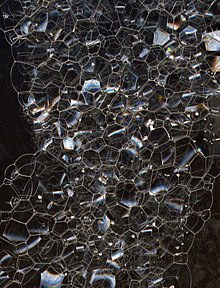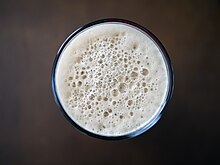
Back رغوة Arabic Espluma AST Köpük Azerbaijani Пяна Bulgarian ফেনা Bengali/Bangla Escuma Catalan Чопа CE Pěna Czech Кăпăк CV Ewyn Welsh
This article needs additional citations for verification. (February 2015) |



Foams are materials formed by trapping pockets of gas in a liquid or solid.[1][2][3]
A bath sponge and the head on a glass of beer are examples of foams. In most foams, the volume of gas is large, with thin films of liquid or solid separating the regions of gas. Soap foams are also known as suds.
Solid foams can be closed-cell or open-cell. In closed-cell foam, the gas forms discrete pockets, each completely surrounded by the solid material. In open-cell foam, gas pockets connect to each other. A bath sponge is an example of an open-cell foam: water easily flows through the entire structure, displacing the air. A sleeping mat is an example of a closed-cell foam: gas pockets are sealed from each other so the mat cannot soak up water.
Foams are examples of dispersed media. In general, gas is present, so it divides into gas bubbles of different sizes (i.e., the material is polydisperse)—separated by liquid regions that may form films, thinner and thinner when the liquid phase drains out of the system films.[4] When the principal scale is small, i.e., for a very fine foam, this dispersed medium can be considered a type of colloid.
Foam can also refer to something that is analogous to foam, such as quantum foam.
- ^ "Foam". Merriam-Webster. Archived from the original on 2014-12-09.
- ^ D. Weaire, S. Hutzler, "The Physics of Foams", Oxford University Press, 1999, ISBN 0198510977, ISBN 978-0-1985-1097-0
- ^ I. Cantat, S. Cohen-Addad, F. Elias, F. Graner, R. Höhler, O. Pitois, F. Rouyer, A. Saint-Jalmes, "Foams: structure and dynamics", Oxford University Press, ed. S.J. Cox, 2013, ISBN 9780199662890
- ^ Lucassen, J. (1981). Lucassen-Reijnders, E. H. (ed.). Anionic Surfactants – Physical Chemistry of Surfactant Action. NY, USA: Marcel Dekker.
© MMXXIII Rich X Search. We shall prevail. All rights reserved. Rich X Search